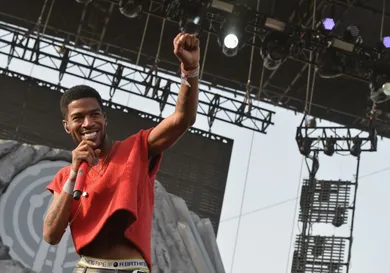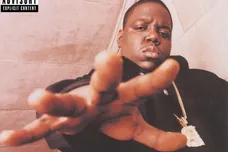It’s no secret that Kid Cudi is a revered source of inspiration among both his peers and his deeply committed fanbase. At a concert in December 2016, Kanye West christened Cudi "the most influential artist of the past ten years." While Kanye has certainly proven himself prone to hyperbole, such a statement is not too far off from the truth. In the decade since he cut his teeth contributing to the music of Jay and Ye, Cudi has become a legend in his own right. Cleveland’s finest has left an undeniable mark on modern music, his musical exorcisms providing a guiding light to those looking to face their fears. The apparitions that have haunted him over the course of his well-documented journey from childhood trauma to addiction to redemption and ultimately rehabilitation have been the muse for impeccable soundscapes and unshakable sadness. There is nothing superficial about Cudi’s artistry, and his intimate understanding of the power of music is peppered with various ingredients. At times, his auto-tuned dancing is the focal point of glitchy cloud rap and ethereal dream pop orchestration. Elsewhere, he’s a whirling dervish slamming his fists into walls and seething about the shortcomings of fame. These in-the-booth therapy sessions, some abstract and some straightforward, criss-cross galaxies while allowing Cudi to speak his truth into a world terrified of being eaten alive by loneliness. His unabashed willingness to experiment, paired with his consistent pursuit of authenticity, is admirable, even if there have been lulls along the way. As is the case with every artist’s discography, no two albums are created equal: times change and so do the creators behind the music, often to the chagrin of critics and casual listeners alike. But when Cudi captures the magic that first enthralled listeners on A Kid Named Cudi, he delivers music that pierces the outermost reaches of the imagination.
If you missed it, you may also enjoy our Top 30 Best Kid Cudi Songs here.
Disclaimer: this list encompasses Cudi’s solo and collaborative studio albums. As such, it does not include mixtapes or unofficial projects.
Speedin' Bullet 2 Heaven (2015)
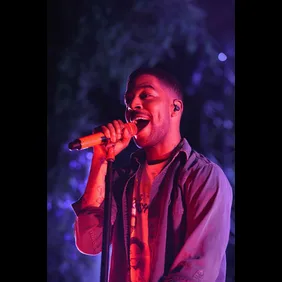
Cudi’s self-mythologizing is polarizing in its ability to either beckon the listener in or push them away. In the case of Speedin’ Bullet 2 Heaven, the latter is the principal outcome of this dichotomy. If WZRD was middling artistic whimsy, then SBH2 is a sharp stylistic swerve that missed the mark entirely. The consensus lowpoint of Cudi’s unpredictable spurts of output, SB2H is an execrable grunge-rap game of Russian roulette. Although the bewilderingly unpolished, 90-minute double-disc has accrued a cult following of sorts in the years since its release, it remains an experiment that many would prefer not to rehash. It received a horrendous reception, and for good reason: even a cursory listen reveals the album’s glaring flaws. SB2H has the feel of an aimlessly self-indulgent science project that was thrown together using Elmer’s glue and painfully forced “Beavis and Butthead” skits. The shallow demos are nothing more than a disarray of psychedelic acoustics, where Cudi’s attempts to dual-wield the mic and guitar yield half-baked and shiftless results. He desperately tries to capture the unplugged nature of acts like Nirvana and The Pixies with a confessional tone that is shit-faced in its bluntness: look no further than the derivative and self-mutilating “Judgemental Cunt” or bumbling “The Nothing.” Cudi doesn’t present anything unique, and his unrepentant lashing, greased with bouts of mainlined narcissism, isn’t particularly attractive. Though he’s never been afraid to take the road less traveled, Cudi’s schizophrenic musical tendencies here prevent him from combining his many aspirations into something even remotely cohesive. The few exceptions that don’t leave a sour taste in one’s mouth, like “Confused!,” are grounded in their meditative simplicity and willingness to ride a few strumming chords. On the album’s titular track, Cudi’s solemn poetry bleeds with a soft pulse, as he ponders manic depression: "If I crash, or when I land, no matter the case, I’m all smiles."
A conglomerate of identically moody anthems is far from desirable. But on SB2H, Cudi is his own worst enemy, employing a crudely dated and misguided approach. Whether or not there is anything redeemable to be dredged up from the rubble is cast into doubt with each snarling sabotage. It’s far from a pleasurable listen, but if you’re not concerned with execution and are willing to suspend expectations to appease Cudi’s refusal of conformity, then perhaps SB2H will be your cup of tea, though this is a dubious prospect at best. If Andre 3000 labeled it “the best thing to come out in a long time,” that’s got to count for something, right?
WZRD (2012)
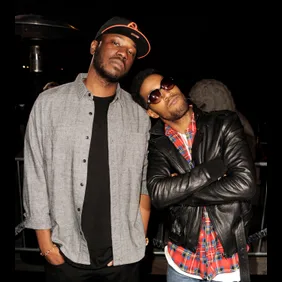
At first glance, this little-noticed rap-rock side project would seem to work. Besides, who better to act as a foil to Cudi’s hypnotics than longtime collaborator Dot Da Genius, who Cudi first started recording with back in 2006. Unfortunately, the duo situate themselves within the preconceived confines of a genre before fully exploring their own sound. As such, the album’s progression is cut short, though not before standouts like the acoustic “Efflictim” and boozy ballad “Teleport 2 Me, Jamie” cut through the blase staccato. Tracks like “Dream Time Machine” are proof that Cudi has a formula worth paying attention to, albeit one that is less rock-inspired than he would like. “Dr. Pill” comes off as morbidly flat, and the Leadbelly/Nirvana cover “Where Did You Sleep Last Night?” does next to nothing in reworking the original. Though WZRD’s punk influences aren’t necessarily a complete artistic U-turn, they give into many of the same assumptions that made Lil Wayne’s foray on Rebirth such an impressionistic butcher-fest. Its lugubriousness and absence of spontaneity leaves many of the instrumentals to wallow in immediately forgettable doldrums. The forced rockstar cliches erect roadblocks in front of Cudi’s adventurous introspection and seemingly genuine desire to push the envelope. There was no happy medium for those who initially tuned into the atypical undertaking: rock fans couldn’t be bothered with WZRD’s stifling mediocrity, while rap fans were unable to fathom why Cudi had rerouted his forecasted flightpath. It’s one thing to commend an artist for breaking new ground, but when the statement of purpose falls woefully short of doing so, then it leaves one wondering why the artist abandoned their initial direction in the first place. To this day, WZRD feels like an album that never quite found its footing, despite the best intentions of its creators.
Satellite Flight: The Journey to Mother Moon (2014)

Satellite Flight is a precipitous, if meticulously constructed, cosmic vista: if you lean too far forward to peer into the void, you just might lose your grip. This surprise digital-only drop offers out-of-this-world ambiance and a startlingly vast atmosphere that ascends with a swelling opening theme. Cudi looks to channel Almost Famous one-liner (“It’s all happening”) on “Going to the Ceremony,” the epic-proportions of the star-kissed troubadour’s journey springing to life. Cudi is skipping stones from the stoop of the abyss, hoping that something will connect with gravity-bound listeners below. For the most part, he succeeds: “Too Bad I Have To Destroy You” glitters with a metallic sheen, while “Copernicus Landing” is a glowing mass of intricate textures. The sinfully sensual “Balmain Jeans,” assisted by Raphael Saadiq, courses with a passionate urgency, its not-so-subtle space sex innuendos (“Can I come inside your vortex?”) fogging up the cockpit.
Clocking in at a lean 10 tracks, Satellite Flight feels like it should be a bridge to something more substantial, which at the time of its 2014 release was presumed to be the third entry in the Man on the Moon series. Instead, its supporting sections grow a bit stale and begin to give way in the nebulous pressure cooker. Tracks like “Internal Bleeding” and “Trouble Boy” could have been cast off into the inky blackness and no one would have been any the wiser. For an album that boasts some truly exhilarating pieces of music, Cudi’s return voyage to the astronomical body from whence he came feels fragmented and fragile. Even with the destination input locked and loaded, the horizon is obscured by sparkling inconsistencies. It’s as if Cudi remembers the controls, but is grasping at straws to rekindle the reverb’d haunting of yore, frantically piecing together sonic blips between the asteroids and Milky Way residue.
Indicud (2013)
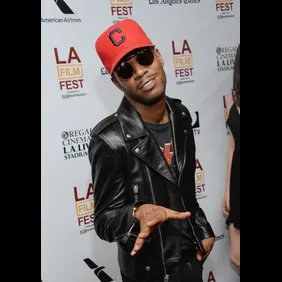
In the weeks leading up to Indicud’s release, Cudi likened the album to Dr. Dre’s The Chronic 2001, with guest artists taking lead roles while he conducted from the pulpit. With Cudi at the helm, the ensuing 18-song collection enlisted everyone from the ever-loquacious RZA (“Beez”) to Father John Misty (“Young Lady”) to none other than Michael Bolton, whose Lonely Island collaboration doesn’t feel so brazenly out there in light of the nine-minute hybrid opus that is “Afterwards (Bring Yo Friends).” Sure the house rambling feels a bit gimmicky, but it somehow works. Others like Kendrick Lamar (“Solo Dolo, Part II”) feel as if they’ve stumbled into the quixotic romp to collect a paycheck and bounce. Even though Cudi perhaps overplayed his hand as the generous host, his unorthodox curatorial skills expanded the album’s scope. With an intriguing crock pot of collaborators in tow, Cudi’s angsty posturing is more enlivened, his slurred “Cudi-isms” reeking of napalm. The defiant and triumphant “Just What I Am” is an essential cut that has aged remarkably well, while the self-righteous “King Wizard” and fuzzy electro-pop of “Immortal” are framed by Cudi’s grandiosity. His thrilling, deviant brand of brain-melting insomnia is reanimated on “Unfuckwittable,” and the mercurial battle between the dark and the light feels more fraught than ever on “Lord of the Sad and Lonely.” The pockets of calm are rare and short-lived, each cinematic chorus injected with token doses of depression, nihilism, and self-deprecating optimism. Listening to Indicud is like trying to dig through the rusty shrapnel of a long-deserted battlefield where only Cudi remains, a raging maelstrom lost in the monotony of his troubles. The album’s antics don't falter from a lack of charisma, but instead suffer due to meager variety, a shortcoming that becomes more pronounced with every listen. If nothing else, Indicud boldly underlined Cudi’s keen ear and conceptual maturation.
Passion, Pain & Demon Slayin' (2016)

Released the same year that Cudi checked himself into rehab for “suicidal urges,” Passion, Pain & Demon Slayin’ is a welcome return to the familiarity of his two defining projects from 2009 and 2010. Formidable and prosaic in its structure, Cudi’s sixth studio album finds the familiar stargazer wiping the moondust from his Bape space suit, ready to step back into the Cudi Zone with a renewed composure. Though at times heavy-handed and long-winded, the 19-track, 82-minute affair remedies many of the crucial missteps of Speedin’ Bullet 2 Heaven and replaces them with markedly refined motifs. Cudi has never thrived on an ingenuity as a lyricist, or wowed listeners with impressive, multisyllabic rhyme schemes. Instead, his charm is his inherent relatability, and his ability to flesh out portals to altered states of mind. This expansive universe opens up if you’re willing to pay the surcharge and buy into his hum-singing “frequency” and husky self-importance. The sheer repetitive volume of this grappling for agency may test the limits of the listener’s attention span, as redundancies render many tracks filler material. Still, there are warm patches to be found in the icy depths. Soaring soapbox songs like “The Commander” and “Cosmic Warrior” are of a celestial nature, as if plucked from the furthest reaches of space by Matthew McConaughey (thinking of his performance in Interstellar, not the fleet of fascinatingly bizarre Lincoln commercials). Andre 3000’s meandering, island-tinged hook on “By Design” is a masterful embrace, while Travis Scott’s pitched auto-croon on “Baptized in Fire” is hair-raising. “Rose Golden” burns with a campfire-like aura, and the self-affirming “Surfin’” harkens back to the catchy high points of Cudi’s early career when he was first beginning to carve his own wave. While it may be a symphony with one too many acts, Passion, Pain & Demon Slayin’ is still an affecting minimalist offering delivered on the self-proclaimed outlier’s own terms.
Kids See Ghosts (2018)
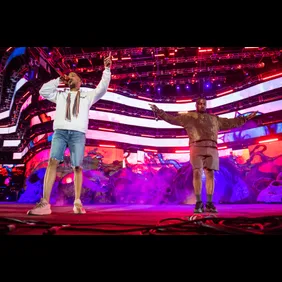
Kids See Ghosts is Cudi’s collaborative project with mentor Kanye West, whose incessant jawing over the course of the summer 2018 G.O.O.D. Music rollout was both intoxicating and deeply befuddling. The spectre of Yeezy Season hung like a threatening storm cloud over each widescreen production showcase that emerged from the mountains of Kanye’s Wyoming bunker. And yet, the final Kids See Ghosts product is intriguing and astoundingly poignant. For once, the details feel “ironed out,” as resident drug dealer extraordinaire Pusha T boasts on tribal opener “Feel the Love.” Kanye’s sinister and ridiculous Big Shaq impression is deafening, ratcheted into the supernatural silence. For Cudi and Kanye, numbness is freedom, and being broken is a peephole into the nothingness. Distorted percussion lends itself to this chaotic mindstate on centerpiece “Freeee (Ghost Town Pt. 2),” the logical follow-up to ye’s “Ghost Town.” Cudi is the album’s undisputed spiritual backbone, his quest to deliver a complete body of work finally coming to fruition. You can hear the pain on “Reborn,” a mission statement where the two artists engulf themselves in plainspoken honesty in the name of confronting the afflictions of mental health. Kanye parades around the apparent bipolar diagnosis acknowledged on the cover of ye, his lawlessness fueled by an insatiable desire to spurn censure. “Peace is something that starts with me,” Cudi sings, his soulful revelations providing a welcome balance to West’s most unstable proclivities. The two no longer question one another’s instincts; instead, they let the free-wheeling brevity breathe. The salvation of closing track “Cudi Montage” is the thematic capstone, a track on which Kanye revisits the toll of cyclical violence and makes a plea for the inner tranquility that has evaded him all these years: “Lord shine your light on me, save me please.” Kids See Ghosts drills home the reality of the duo’s symbiotic relationship, as Cudi and Kanye augment each other’s on-wax presences to tease out an embarrassment of riches in every nook and cranny.
Man on the Moon II: The Legend of Mr. Rager (2010)
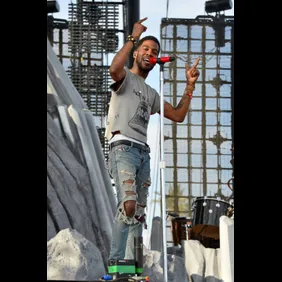
“You are now in the world that I’m ruining” is the ominous opening line that ushers listeners back into the realm of Mr. Solo Dolo. The brilliant second entry in the Man on the Moon series is the darkest and most volatile in Cudi’s discography. Where its predecessor has more carefully tailored pop leanings meant for wider appeal, The Legend of Mr. Rager swallows and spews liquid regret, its harrowing cracks at drug addiction, anxiety, and relationship struggles making for beautifully twisted moments of expression. Though the “clusterfuck of fun and enchantment” still flirted with crossover acceptance, the troubled hip-hop existentialist’s on-the-record confessions were more contradictory and fascinating in their leftfield attempts. Anguish cocktails “Ghost!” and “All Along” hinted at future alt-rock excursions, while Cudi’s overarching intentions are made clear in the slick chorus and guitar lick of “Erase Me,” the big-brother martyrdom of “REVOFEV,” and the throbbing wails of Mary J. Blige on “Don’t Play This Song.” The emotional gesturing that was hinted at on the first installment feels more realized, even if the psychic hemorrhaging within is at times a bit cumbersome. Amidst all the coked-up braggadocio, melodrama, and surly half-sung vocals, Cudi is still searching for the silver lining, the ghost-in-the-machine forever raging against his mortal coil. The Legend of Mr. Rager presents a melodic palette that delves into the belly of the beast, where enigmatic anti-hero “Mr. Rager” is juxtaposed with the degenerative moping of Eeyore on painkillers.
Man on the Moon: The End of Day (2009)
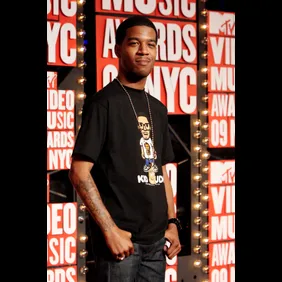
Building on the blueprint that Cudi hand-crafted with Kanye on 808s & Heartbreak, Man on the Moon: The End of Day would prove to be one of the most significant albums of the 21st century. It was the transcendent mecca for a generation of artists looking to transcribe inner turmoil into commercial resiliency. Though the stream-of-consciousness mood piece wasn’t a perfect debut, Cudi’s murky interior monologue offered moments of genius in conjunction with electro-rockers MGMT and Ratatat. A now indispensable voice, Cudi’s arrival on the mainstream scene was integral to the genre’s evolution in a way that 2009 industry gatekeepers couldn’t have possibly predicted. The success of internet smash “Day ‘N’ Night,” which placed the Kanye consultant squarely in the spotlight alongside brooding upstart Drake, doubled down on hipster backpack rap as more than just a sad fad. Cudi’s emo overtures were here to stay, even as he hastened to juggle indie credibility on a pop platform.
The End of Day quickly sets up the story of the “lonely stoner,” the obscure space-case protagonist consigned to the “dark side of the moon.” Drug references abound: Cudi enlists compulsive druggie philosophy and mind-altering substances in an effort to escape the night terrors that plague him. Although the hallucinatory diary entries are occasionally clumsy and underwritten in their construction, Cudi’s raw ambition is immediately praiseworthy. He endeared himself to fans by flaunting his vulnerabilities, running through the gauntlet of emotions to provide a window into the mind of an eclectic tinkerer. His downcast heroics made effective use of frigid synthesizers, gothic keyboards, and woozy electronic odds and ends, the ideal wheelhouse for his brand of refreshing personal transparency. With sporadic Planet Earth-like narration from Common, Cudi probed the waters of forlorn self-pity and societal disenchantment, gradually taking on legendary proportions for twenty-somethings who remember the spongy teenage intensity of “Pursuit of Happiness.”
